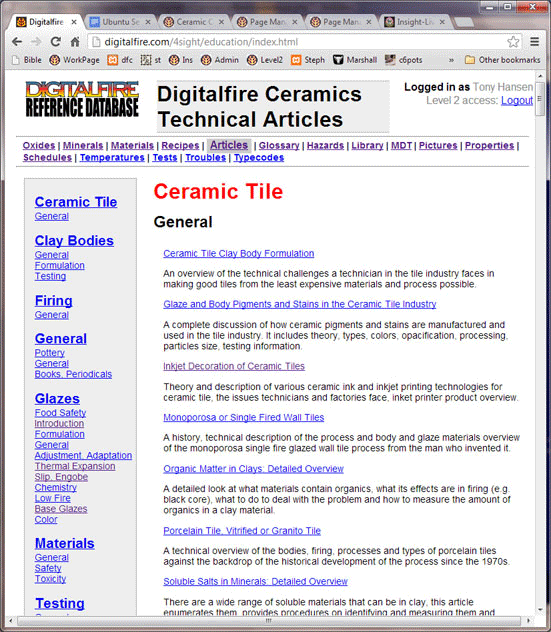
Technical Ceramic Library Like No Other
This is a growing materials-centric knowledge base of 4,000+ pages and 15,000+ interlinks with information on how to formulate, adjust and troubleshoot traditional ceramic bodies and glazes. While much of it is freely available to everyone Level 2 Insight owners get direct quick reference links and access to more information when logged in here. Insight-live is built around this database and takes it to new levels giving users the ability to create their own private databases and weave them into this data.
More Details


No book can organize information in the manner set out here. It is organized hierarchically to model the real-world presence of what ceramic technicians have to deal with. For example, glaze or body recipes are made from materials, these materials in turn are composed of oxides and minerals. The database organizes this way. So if a piece of information relates to the way the material behaves physically, this is recorded with the material. However if a behavior is a product of a mineral in that material, the material has a link to the mineral and the main part of the information is with that mineral. Likewise, if a behavior of a fired glaze is related to the presence of a specific oxide, there is a link to the oxide and the notes about that behavior are there. Since the same oxide is in many materials, details of its behavior only need to be recorded in that one place.
- Materials also have hazards, properties, memberships in MDTs, pictures, temperature events; these are likewise linked and documented in their own areas.
- Recipes also have associated firing schedules, testing regimens, pictures and potential process faults; these also are linked and documented in their own areas.
- Some areas interlink to almost all of the others. For example pictures. The same picture can also link to different records in different areas. Likewise with the library and typecodes areas, they tie together records from others into groups.
- The glossary area acts as an entry point for many concepts, linking to the appropriate place in the hierarchy for further investigation.
- The properties area consolidates things like how to produce a specific glaze color or a glaze effect. For example, if specific materials or oxides have a mechanism that can produce a matte glaze, these mechanisms are linked to and recorded in the properties area. If this way, you can investigate a specific mechanism and have links to all the ways to do it.
- The firing schedules area is valuable also, it links schedules to recipes and presents them in a way that is easy to program into a controller.
- The temperatures area documents milestone temperatures for many materials (temperatures at which they decompose, melt, transform, etc.). This type of information is valuable in designing firing schedules and troubleshooting firing faults.
- The testing area defines procedures for a wide range of tests (a links them to other areas as appropriate). These provide the basis for the test data collection functions of Insight-live.com.
What People are Saying

"Thank you for all the wonderful work you do for the ceramic community."
"I'm all right brained..... I have the serial number. My computer is finally going. Thanks for the service. I love my Digital fire."
"This article is just what I have been looking for, actually for years. I am going to experiment making my shiny clear glaze matte. I do not have an MFA and have not really ever studied glaze calculation and yet I understand this article and know where to start. Thank you!!!"
"I have been browsing the ceramic materials site with some of the Bastarache articles and their links. Extremely helpful information. Thank you both you and Edouard!"
"I am a builder / developer / consumer of ceramic tiles. You have a sea of information on your site."
"Thanks - your help has always been prompt and useful."
"As a new potter, your website has been an incredible source of information for me, both in tips, recipes and things to ponder. I know I can speak for a few others when I say please keep posting as the information is highly valued."
"I would also like to say thank you for providing the information about glaze's that you have on your websight. I have been formulating glaze for 20+ years, read practicaly every book on glaze & glass and your web page's had better information than any book."
"I am so glad I found your site, I have been looking for a site with this type of good information."
"I have read just about all your articles on Digitalfire and use your software, really appreciate the wealth of knowledge and testing you bring to ceramics. "
To see more (at random) refresh this page